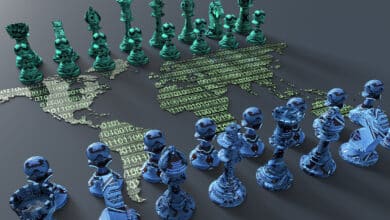Q-Day Isn’t an Outage – It’s a Confidence Crisis

Table of Contents
Introduction: A Quantum Leap That Breaks Trust, Not Just Code
Cybersecurity lore often paints Q-Day (the moment a quantum computer cracks RSA/ECC encryption) as an instant “Quantum Apocalypse” where every system gets hacked immediately. Planes falling from the sky, banks drained in seconds, an overnight digital Armageddon – if that nightmare doesn’t happen, some assume Q-Day wasn’t so bad after all.
But this view misses a crucial point. The real catastrophe of Q-Day isn’t that everything will crash at once – it’s that our confidence in all things digital will collapse in an instant. In reality, when quantum code-breaking arrives, nothing visibly “breaks” on day one – websites still load, bank apps still work – yet one of the fundamental pillars of our digital world will have crumbled: trust in our encryption.
Imagine waking up to headlines that researchers have factored an RSA-2048 key with a quantum computer. No cities go dark; your devices don’t explode. Yet beneath the calm surface, every encrypted email, bank transaction, and login that was secure yesterday is suddenly open to doubt. Q-Day is less a “lights out” event and more a silent invasion – the castle walls still stand, but the enemy just found the master key to every gate.
The immediate crisis won’t be computers failing; it will be people – CEOs, governments, consumers – panicking as the trust in all digital systems vanishes. Paradoxically, the skeptics are right on the engineering timelines: even after a credible RSA‑2048 break, commoditized quantum abuse against your local bank or inbox could be years – possibly decades – away. But that doesn’t matter, because markets, regulators, and users react to signals, not qubit counts; perception moves faster than physics.
Let’s define Q‑Day accordingly: not the day everything is hacked, but the day classical cryptography loses the presumption of safety.
Misconception vs. Reality: Not an Instant Hack-a-thon
Misconception: “Quantum Day means everything gets hacked immediately.” Many tech professionals assume that if Q-Day doesn’t bring instant, widespread breaches, then it’s not a big deal. They argue that even once RSA-2048 is broken, quantum computers will be so scarce and expensive that only a few targets (like governments or major banks) will be hit, perhaps years later – so why worry about my business or my local bank?
Reality: It’s true that early quantum attacks will be limited and costly. Breaking a 2048-bit RSA key won’t be cheap or easy, even for a quantum-capable adversary. Recent research by Gidney (2025) suggests factoring one RSA-2048 key might require roughly 1,000-1,400 error-corrected qubits running for about a week. The first successful crack could demand millions of today’s physical qubits or huge runtimes, and enormous power: on the order of tens of megawatt-hours of energy per key. My analysis found that using a superconducting quantum computer to break a single RSA-2048 key might consume ~125 MW of power for 8 hours – roughly $50k-$100k in electricity. In the early days of Q-Day, only nation-states or tech giants could marshal such resources, and they would deploy them sparingly for the highest-value targets.
In short, the sky won’t fall overnight for every user of RSA/ECC once a large quantum computer appears; the threat will roll out gradually, focused on “crown jewel” targets first. Two truths can hold at once: the attack economics stay unfavorable for most targets for years, yet the trust economics flip to risk‑off the instant a credible break is public.
So yes – your favorite local bank or your personal Gmail likely won’t be quantum-hacked on Day 1. Cybercriminals won’t magically “snap their fingers and hack every bank” immediately because quantum resources will initially be extremely scarce and expensive. But here’s the rub: none of that prevents a crisis.
Q-Day’s danger lies in perception and behavior – beliefs outrun bits. The moment it’s proven that our cryptography can be defeated, the universal presumption of security collapses. As I previously noted “the perception of vulnerability can be enough to cause trouble”. We humans won’t calmly wait to see who actually gets hacked – we’ll react as if any encrypted channel could be compromised next. This is textbook loss aversion, herding, and information cascades: if I think others will run first, it becomes rational for me to run now. That collective panic is the real disaster.
The Immediate Fallout: An Instant Collapse of Digital Trust
The instant Q-Day is confirmed, organizations worldwide will shift into crisis mode. Even if no hacker has yet touched your network, everyone now knows the “unbreakable” locks of the internet are effectively picking locks. Confidence in our security systems will evaporate overnight. Expect information cascades: once a few brand‑name institutions move visibly, everyone else will follow – often regardless of their own cryptographic exposure.
This is fundamentally a human response: if the locks on your house were all reported picked open, you wouldn’t sleep well even if no thief has entered yet. Similarly, once RSA/ECC encryption is broken, nothing can be implicitly trusted without proof of quantum-safety. We will see immediate, reflexive reactions:
Financial (Banking & Commerce)
Banks and payment systems will be among the first to act. Major banks might temporarily freeze online transactions or impose withdrawal limits until they confirm their systems are quantum-safe. Even if the average hacker can’t instantly plunder every bank (since quantum computers aren’t omnipresent), the “perception of vulnerability” is enough to spark a financial panic.
Consider a regional bank that hasn’t upgraded its encryption – it may not be an immediate target for a quantum attacker, yet customers could rush to pull funds and move money to institutions that loudly advertise their quantum-resistant security.
We could witness a classic digital-age bank run fueled purely by lack of trust, not by actual theft. In fact, just news of a single successful quantum breach at one bank – even if quickly contained – could send a chill through financial markets, as investors and the public realize any bank could be next.
Stock markets abhor uncertainty, and Q-Day will inject plenty of it. Financial regulators will scramble to issue assurances and demand rapid crypto-upgrades from any banks that “dragged their feet” on post-quantum migration.
In short, expect a crisis of confidence in finance: not a total collapse, but a frenzy of double-checking, emergency audits, and contingency measures as everyone tries to verify which transactions, websites, and records are still trustworthy.
Cryptocurrency & Blockchain
Perhaps the clearest example of Q-Day’s immediate risk is in crypto. Major blockchains like Bitcoin and Ethereum rely on ECC signatures for ownership – crack those, and any known public key becomes an open door. Even without live quantum theft, sentiment will overshoot – crypto markets will price in worst‑case scenarios long before widespread exploitation is feasible.
It’s estimated that over 6 million BTC (about 31% of Bitcoin’s supply) sit in addresses with reuse or exposed public keys, making them low-hanging fruit for a quantum thief. A successful quantum attack could sweep these coins into a hacker’s wallet, a multi-billion dollar heist at current prices.
But even before an attacker does this, the mere realization that it’s possible will trigger chaos in the crypto markets. Prices of major coins would likely plummet overnight as investors panic-sell, and exchanges might halt trading to stem the turmoil.
It’s hard to overstate the shock to the “trustless” blockchain world when its underlying cryptography is proven crackable – it would be a collapse of trust in the entire cryptocurrency ecosystem. Developers might hold emergency meetings to fast-track quantum-safe upgrades (or even freeze vulnerable accounts temporarily), but confidence in the code would be shattered.
Even if initially only nation-states have quantum capability (and they focus on bigger fish like intelligence data), the threat alone will destabilize crypto markets. This illustrates a key Q-Day lesson: it’s the expectation and fear of breach – the shattered illusion of security – that wreaks immediate havoc.
Communications & Data Privacy
In the wake of Q-Day, secure communications will suddenly feel insecure. Organizations may impose “communication blackouts” for sensitive info, fearing that VPNs, encrypted emails, messaging apps, etc. are no longer safe.
Government agencies might instruct staff to stop using email or messaging for classified discussions until quantum-safe channels are in place.
We could see a brief return to analog methods – couriers carrying sealed letters, face-to-face meetings in secure rooms – anything to avoid encryption that might be compromised.
Tech companies will rush out patches, perhaps disabling older TLS protocols and certificates or adding ad-hoc encryption layers, causing some services to glitch as they’re frantically upgraded. Security teams will bias toward false positives – accepting outages and friction rather than risking forged identities or downgraded sessions.
For everyday users, this might mean sudden “pardon our dust” maintenance outages on apps and websites as the digital world scrambles to re-secure itself.
In the extreme, consider digital certificates that secure websites: a quantum attacker who can forge a Certificate Authority’s key could impersonate any website (your bank, a news site, etc.) with a perfect fake certificate. Even one instance of a quantum-forged website or malicious software update (signed with a stolen private key) would erode public faith in that little browser padlock icon.
Trust in digital authenticity – the idea that “if it’s encrypted or signed, it’s genuine” – will be deeply shaken. We’ve long feared “harvest now, decrypt later” for stolen data; Q-Day adds “trust now, forge later” for our digital identities. Losing trust in your systems can be far costlier than losing confidentiality of some data.
Government & Defense
In national security circles, quantum risk has always been about more than IT – it’s strategic. The instant Q-Day hits, intelligence agencies will assume that any encrypted secrets (diplomatic cables, spy identities, military orders) might soon be readable by adversaries.
Governments that have prepared will flip on quantum-resistant communications; those that haven’t may find allies suddenly wary of sharing data. In coalition settings, optics matter: allies will tighten sharing until you can demonstrate quantum‑safe posture, not merely claim it.
For example, within NATO there’s concern that if even one nation lags on upgrading crypto, it becomes the weak link in allied communications.
In the immediate term, militaries might halt routine data transmissions, re-issue keys, and even question the authenticity of orders until new safeguards are in place (imagine the confusion if a quantum attacker could forge a high-level order – no one would know what commands to trust).
Beyond espionage, public-sector leaders worry about citizen trust: if things like taxpayer records or election data were encrypted for confidentiality, Q-Day means those records could potentially be decrypted or tampered with, undermining public trust in government systems.
National leaders will likely make urgent public statements to assure people (truthfully or not) that critical government communications are still secure. But until post-quantum fixes are rolled out, a cloud of uncertainty hangs over every state secret and digital public service.
Critical Infrastructure (Energy, Healthcare, Transport)
Providers of essential services will take a “better safe than sorry” stance. Sectors like electric grids, utilities, hospitals, and transportation rely on encrypted control systems and digitally signed commands. If those protections might fail, operators could switch certain systems to manual mode as a stopgap.
Picture a power grid control center temporarily requiring humans to verify each critical command because the automated secure link can’t be trusted, or a railway signaling system adding physical fail-safes until new encryption is installed.
Hospitals might hesitate to trust remote updates to medical devices, fearing a hacker could spoof a device update and harm patients.
Basically, expect an emergency mindset: assume the worst until proven otherwise. This may cause slowdowns or limited services (imagine delays in power dispatch or flight scheduling due to extra manual checks). While these sectors likely won’t shut down, they’ll operate with caution until their devices and networks get quantum-safe upgrades. Operators will trade efficiency for certainty, deliberately slowing automation until quantum‑safe integrity can be attested.
The irony is that no actual quantum cyberattack needs to occur to create disruption – the possibility is enough. Operators know that a forged command in a pipeline or a false sensor reading in a chemical plant could be catastrophic, so they will act (and spend) to prevent any uncertainty in system integrity.
As I keep arguing for decades, once adversaries can break digital signatures at will, the collapse of integrity could lead to “equipment damage, environmental disasters, even loss of life” in critical infrastructure. Little wonder that human safety protocols will kick in immediately on Q-Day – better to endure a few days of inconvenience than risk a quantum-enabled sabotage of a power plant or traffic system.
The Human Factor: Why Preparation (and Communication) Is Key
In all the examples above, a common theme emerges: the sky isn’t falling all at once, but the ground is shifting beneath our feet. Q-Day will be a slow-burn chaos – a series of growing cracks rather than one big explosion.
This is why the techies’ point and mine can both be true: attack economics may delay direct targeting of most organizations, yet trust economics flip instantly once a credible paper lands. Engineers optimize for correctness; markets optimize for confidence – and on Q‑Day those timelines decouple.
Each passing week after the breakthrough, another disturbing incident or near-miss will hit headlines (a leaked trove of previously secure data here, a spoofed certificate attack there, a bank panic over unverified transactions over there). The broader public might not grasp the technical details on Day 1, but they’ll quickly learn that something fundamental has changed in our digital world.
And critically, the damage one suffers will depend on how prepared they were. Companies and governments that heeded the warnings and began integrating post-quantum defenses early will fare far better, perhaps experiencing only minor issues or public reassurance that “we’ve got this.”
The procrastinators will be in full-blown crisis, scrambling under pressure while the whole world is watching. Q-Day will separate the proactive from the unprepared in a very public way. Regulators and lawmakers, too, will likely come down hard with “Why didn’t you upgrade when you had time?!”.
Ultimately, the real risk of Q-Day is human behavior. Panic, distrust, and knee-jerk decisions can cause far more immediate damage than the quantum computer itself. A bank that hasn’t been hacked can still suffer a run if it can’t prove its security. A power grid can stay online yet trigger outages if operators shut systems off out of caution. The collapse of digital trust – even briefly – would paralyze commerce, communications, and society in a way that no mere computer bug could. In many industries, integrity and confidence are paramount; losing trust in systems can be more devastating than a contained breach. Q-Day represents a crisis of trust at a global scale.
To blunt irrational cascades, you need pre‑positioned proofs, not promises: hybrid‑TLS endpoints, PQC‑signed artifacts, and public attestations you can show on Day 0.
The good news? Unlike natural disasters, this one is foreseen. We know Q-Day is coming (current consensus places it around the early 2030s given recent quantum tech breakthroughs) and we have a window to prepare. The catastrophe is avoidable if we act in time.
In the end, Q-Day isn’t just about qubits and algorithms – it’s about people. Those who treat it purely as a distant technical problem (“maybe it won’t affect me for years, if ever…”) risk being caught flat-footed in the worst possible way. But those who understand that digital trust is fragile will help ensure that Q-Day is remembered as a challenging transition, not the day the digital world stood still. That’s why, in my vocabulary, Q‑Day is the day trust in classical crypto collapses – not the day everything gets hacked.
Quantum Upside & Quantum Risk - Handled
My company - Applied Quantum - helps governments, enterprises, and investors prepare for both the upside and the risk of quantum technologies. We deliver concise board and investor briefings; demystify quantum computing, sensing, and communications; craft national and corporate strategies to capture advantage; and turn plans into delivery. We help you mitigate the cquantum risk by executing crypto‑inventory, crypto‑agility implementation, PQC migration, and broader defenses against the quantum threat. We run vendor due diligence, proof‑of‑value pilots, standards and policy alignment, workforce training, and procurement support, then oversee implementation across your organization. Contact me if you want help.



